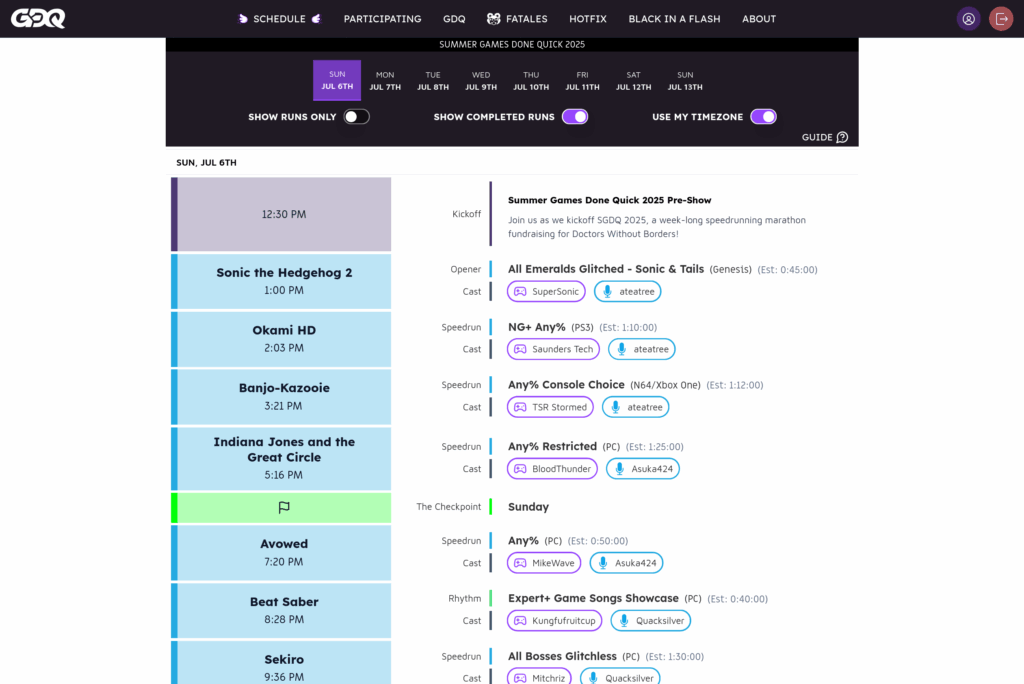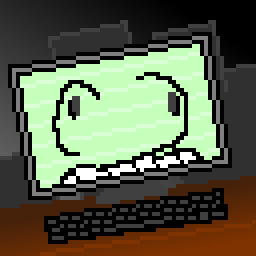As noted yesterday, I forgot about SGDQ this year and we’re already underway. But there’s still five-and-a-half days of it left, so here’s some projected highlights and notes. Nearly every day of the weeklong charity speedrunning marathon this year has a Legend of Zelda game. I’ve boldfaced them below to point them out! All times US Eastern. For the full rundown, check the schedule page. And you can watch the marathon in progress here!
I’m pushing the next @Play to tomorrow since this one’s pretty time sensitive. See you with that tomorrow!
Past, Sunday
These should be on Youtube soon, if they aren’t already by the time this is published.
Sonic Frontiers, Any%
Bugsnax, All Bosses Co-Op
Mega Man Maker, Any% – hey, we recently linked to that! I have no idea what “Any %” means for a level construction program.
F-Zero X Expansion Kit, All Tracks (should be interesting, this didn’t get a release outside of Japan!)
The Legend of Zelda: The Minish Cap, Any%
Luigi’s Mansion 100% Race, on Wii
Past, Monday
Banjo-Kazooie, 110% no FFM (FFM stands for “Furnace Fun Moves,” it’s a way to get the moves from a different save file unlocked on a current save, they’re saying they won’t do that, even though it’s possible)
Loom, Any% (always nice to see a Lucasarts classic here)
Michael Jackson’s Moonwalker, Any%, on the Sega Genesis (not the even-more-bizarre arcade game)
Metal Slug XX, Normal Difficulty, Any %
Present, Monday
Here begin the runs that you might still have a chance to catch-
9:58 AM: PHOGS!, Solo Any% (this is an indie release with a bizarre premise, the character is a stretchy dog with a head on both ends, huh)
12:55 PM: Crisis Core: Final Fantasy VII – Reunion, Any% Race
2:24 PM: Peggle Deluxe, Any% (yes, Peggle)
5:18 PM: Sly Cooper and the Thievius Raccoonus, All Keys
6:42 PM: The Legend of Zelda: A Link Between Worlds, Any% (given the success of BotW and TotK, probably the last “traditional” Zelda game we’ll see for awhile)
8:29 PM: Igavania sequence! Bloodstained: Curse of the Moon, its sequel, and as a possible bonus game Symphony of the Night
11:33 PM: StepMania DX, Game Showcase, Arcade
Tuesday
1:39 AM: Hearthstone: Knights of the Frozen Throne, Solo Adventures
5:50 AM: SNOLF, Any% No Coordinate Warp (it’s a hack of Sonic 2 where you play golf with Sonic)
6:40 AM: Marathon Infinity, All Main Levels on Kindergarten Difficulty (sadly it’s a PC port, not on a classic Macintosh)
8:00 AM: Maniac Mansion, Any%, NES (only eight minutes is blocked for this, so don’t blink!)
4:16 PM: The Elder Scrolls Anthology, Main Series
8:00 PM: Halo 3, Legendary Difficulty, as a bonus game
Wednesday
5:25 AM: Dead Rising 2, Time Skip NG
9:19 AM: Gauntlet, Any% Co-Op, NES (only 20 minutes for this)
11:55 AM: Touhou 14.3: Impossible Spell Card, All Scenes No Items (I’d make a joke about this being for the kids out there, but Touhou’s been around for quite a while now, I’m just old)
1:32 PM: Shatterhand, Any% on NES (24 minutes, it’d be nice to have another NES game in a GDQ that’s not over in half an hour or less)
3:06 PM: Trine Enchanted Edition, Any% NG+
3:41 PM: N++, Co-op Legacy X-row (remember when this was just a Flash game? remember when there were Flash games?)
5:08 PM: Shadow the Hedgehog, Glitchless Bidwar (oooh edgy)
5:58 PM: Sonic Adventure DX, All Stories Relay
8:00 PM: The Legend of Zelda: Majoras Mask, Blitz Randomizer (randomizer runs are always fun!)
10:42 PM: Super Mario Odyssey, Any% as a bonus game
Thursday
12:16 AM: Paper Mario, Any% no ACE (“ace” stands for Arbitrary Code Execution, it’s one of those sneaky ways to glitch a game out to get to the end immediately, they’re saying they aren’t doing that)
3:46 AM: Golf It!, Classic First 5 Maps 100% Race (Golf It, which according to nearly the entire first page of Google hits for it is “a multiplayer Minigolf game with focus on a dynamic, fun and creative multiplayer experience,” blergh, is one of those silly golf games along the lines of What The Golf)
4:26 PM: Hobo Cat Adventures, Any%
5:51 AM: Give Me Toilet Paper!, Hand% (maybe we’re in Awful Block, because the next game is….)
6:14 AM: Pepsiman, Any% (yep)
8:54 AM: Pocky & Rocky Reshrined, Any% with Uzumi
9:39 AM: The Curse of Monkey Island, Any% Mega-Monkey (increases the number of puzzles!)
10:13 AM: Grand Theft Auto: San Andreas, Any%
2:45 PM: Darkest Dungeon
4:45 PM: The Legend of Zelda: Twilight Princess, Any% (nice to see a Zelda game that hasn’t been compressed into nothing, three hours is blocked off for this which is a lot longer than for Breath of the Wild)
7:57 PM: Pizza Tower, Any% (yay!)
Friday
12:13 AM: Crash Bandicoot: N. Sane Trilogy, Full Trilogy Any%
4:17 AM: Shantae and the Pirate’s Curse, All Dark Magic, Pirate Mode, No OOB
5:47 AM: Klonoa Phantasy Reverie Series, Klonoa 1 Any% Easy Support Mode
6:52 AM: VVVVVV, Any% Glitchless
7:24 AM: SaGa Frontier, Story Bidwar
8:39 AM: Final Fight 3, Co-Op Any% (Easy), on SNES
There’s a lot of short games around here….
11:24 AM: X-Men Arcade, 2-player 1CC attempt (there should be more arcade games at GDQ)
12:45 PM: The Legend of Zelda: Four Swords, Any% Co-op, on GBA (one of the least Zelda-like Zeldas)
1:25 PM: Metroid Prime Remastered, Any%
3:42 PM: Pokémon Colosseum, Any% Race (four hours for this one, it’s the traditional very long Pokemon playthrough, although this time it’s for one of the side-series battlers, a sequel to Pokemon Stadium)
8:09 PM: Kaizo Monkey Ball, Story Mode (this is a hack of a Super Monkey Ball game to make it even harder)
Saturday
12:16 AM: Celeste, TAS True Ending
1:02 AM: Super Mario 64, Randomizer- 70 Star Non-Stop
1:59 AM: Kingdom Hearts Final Mix, Any% Proud Race
6:09 AM: Neopets: The Darkest Faerie, Any% (Neopets!)
7:14 AM: Tony Hawk’s Underground, Beginner Any%
8:04 AM: Spelunky 2, Spelunker Trials Any%
9:19 AM: Billy Hatcher and the Giant Egg, Any% (while it has its flaws, this is an underrated game)
10:41 AM: Final Fantasy IV Pixel Remaster, Any%
2:56 PM: Super Mario Bros., Any% Warpless (20 minutes blocked for this, which is surprising to me)
5:01 PM: Pokemon Violet/Scarlet, Victory Road (a relatively traditional style of Pokemon play in this open world game)
7:46 PM: Elden Ring, Any% Glitchless
11:26 PM: The Legend of Zelda: Breath of the Wild, Any% Blindfolded as a bonus game
Sunday
3:14 AM: Super Metroid, Co-Op Any% (Super Metroid is a traditional GDQ marathon ender. save the animals!)





